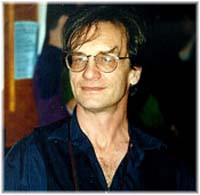Some influences are noteable, namely that of horror-and-fantasy
writer Lovecraft and of draftsman Wrightson. Of Berni Wrightson
(whom Andreas introduces in the first story as the young writer
Bernard Wright) we recognize the typical, cramped postures of the
persons: wide spread legs and arms, tendinous hands, faces with
mouths whose ends are drawn downwards, and the 19th century
clothing and waving cloaks. Furthermore Wrightson uses certain,
very conspicuous camera positions, like the bird perspective (for
example looking into the room from between the beams of the
ceiling). He also has a specific way of drawing lines, among
others a specific way of indicating shadows, namely by hatching.
We find this in Andreas work unmistakably. In the
black-and-white pictures that are published at the start of the
first Rork album, Fragments, are published we
recognize Wrightson's last work so precisely, the black-and-white
illustrations for Mary Shelley's 'Frankenstein', that we
can see this as an ode. In his strips Andreas shows that he is
very well capable of telling his own story, even with borrowed
techniques. He perfects these techniques as well, and uses them
in a very personal way. For example he uses a very abnormal page
layout and often plain spectacular perspectives.

Berni Wrightson
